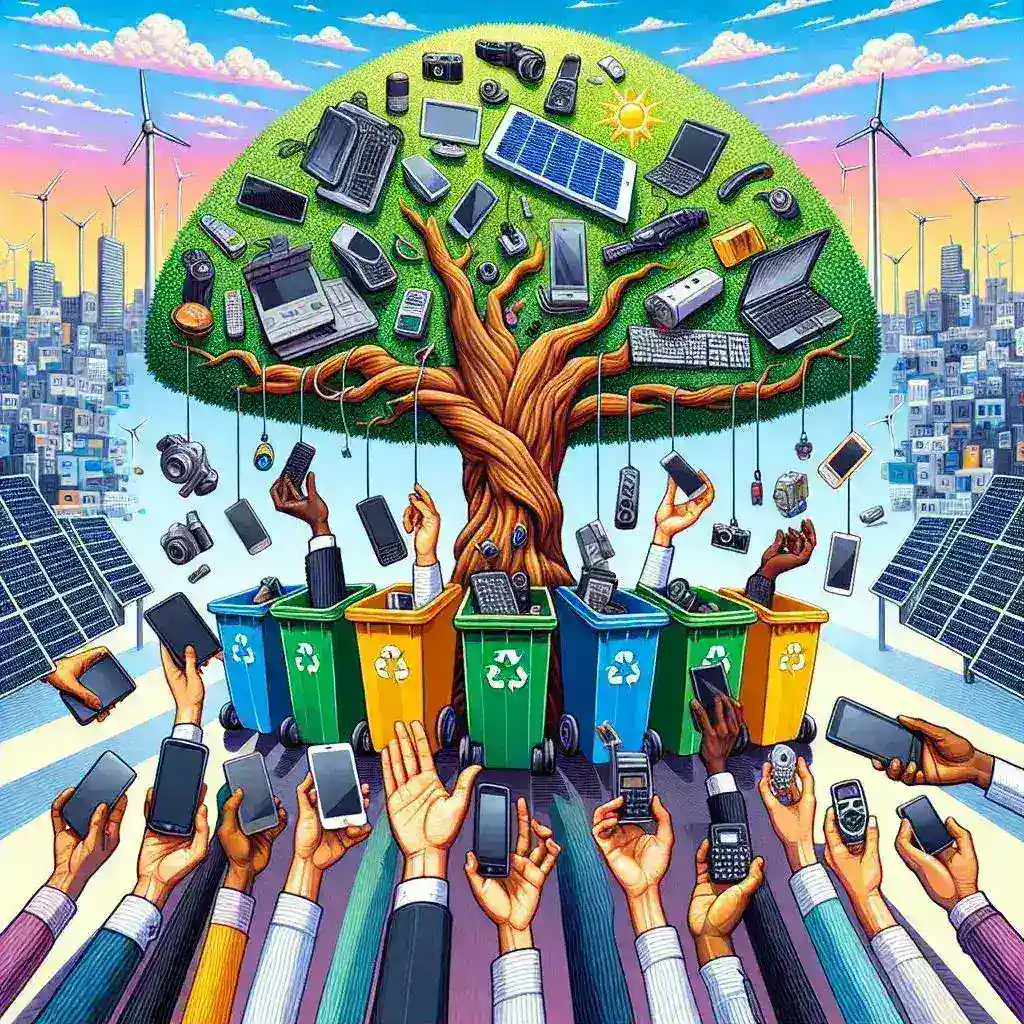In today’s rapidly advancing technological landscape, the lifespan of our gadgets has significantly shortened. Whether it’s a smartphone, laptop, or even a simple radio, these devices often end up in landfills, contributing to a massive environmental problem known as e-waste. However, there are responsible ways to deal with old electronics, and recycling is one of the most effective methods. This comprehensive guide will walk you through the steps of how to recycle old electronics, ensuring both environmental sustainability and personal security.
The Importance of Recycling Old Electronics
Recycling old electronics is crucial for several reasons, primarily environmental and economic. When electronic devices are improperly disposed of, they can release harmful chemicals and materials into the environment. These substances, such as lead, mercury, and cadmium, can contaminate soil and water, posing serious health risks to humans and wildlife. Additionally, electronic waste often contains valuable metals like gold, silver, and copper, which can be recovered and reused, reducing the need for new mining and conserving natural resources.
Economically, recycling electronics creates jobs and supports local businesses. It also helps reduce the cost of manufacturing new devices by providing a source of raw materials. By recycling, we not only help protect the planet but also contribute to a more sustainable and efficient economy.
Understanding E-Waste
Electronic waste, or e-waste, refers to discarded electrical or electronic devices. This includes everything from smartphones and laptops to refrigerators and washing machines. E-waste is one of the fastest-growing waste streams globally, and its improper disposal poses significant challenges. According to the Global E-waste Monitor 2020, the world produced a staggering 53.6 million metric tons of e-waste in 2019, with only 17.4% properly recycled.
The remaining 82.6% of e-waste either ended up in landfills, was incinerated, or simply dumped in developing countries where it is poorly managed. This unregulated disposal not only harms the environment but also contributes to social and economic issues, such as the exploitation of workers in informal recycling operations.
Preparing Your Devices for Recycling
Before you recycle your old electronics, it’s essential to prepare them properly. Here are some steps to ensure your devices are ready for recycling:
- Backup Your Data: Before recycling any device, make sure to back up all important data. Use cloud services, external hard drives, or USB flash drives to store your files, photos, and documents.
- Factory Reset: Perform a factory reset on your device to erase all personal information. For smartphones and tablets, go to the settings and select ‘Reset’ or ‘Factory Reset.’ On laptops, you can typically do this through the device’s recovery options or by reinstalling the operating system.
- Remove Personal Information: Ensure that all apps, accounts, and settings are removed from your device. Log out of email accounts, social media platforms, and any other services to prevent unauthorized access.
- Uninstall Software: If you’re recycling a computer, uninstall any software that might contain sensitive information or that you have licenses for. You can usually do this through the control panel or similar settings menu.
- Check for Warranties or Insurance: Verify whether your device is still under warranty or covered by insurance. Some manufacturers offer free recycling programs, and insurance policies might cover the cost of recycling.
By taking these steps, you can ensure that your personal data is secure and that your device is in a state ready for recycling.
Where to Recycle Old Electronics
Finding the right place to recycle your old electronics is crucial. Here are some reliable options:
- Manufacturer Programs: Many electronics manufacturers have their own recycling programs. Companies like Apple, Samsung, and Dell offer free or discounted recycling services for their products. Check their websites for details on how to participate.
- Retail Stores: Some retail stores, such as Best Buy and Staples, provide electronics recycling services. They may have drop-off bins or specific events dedicated to collecting e-waste. Visit their websites or local stores to learn more.
- Municipal Recycling Centers: Many cities and towns have designated recycling centers for electronic waste. These centers are equipped to handle a wide range of devices and often offer free or low-cost services. Check your local government’s website for information on e-waste recycling facilities.
- Community Events: Community organizations and nonprofits frequently host e-waste recycling events. These events are a great opportunity to dispose of multiple devices at once and ensure they are handled responsibly. Look for announcements in local newspapers or community boards.
- Online Recycling Services: Several online platforms specialize in e-waste recycling. Websites like Gazelle, ecoATM, and uSell allow you to sell or recycle your devices for cash or credit. They often provide prepaid shipping labels for convenience.
When choosing a recycling center, look for certifications like R2 (Responsible Recycling) and e-Stewards, which indicate that the facility adheres to strict environmental and safety standards.
Step-by-Step Guide to Recycling Old Electronics
Recycling old electronics is a straightforward process, but it requires attention to detail. Follow these steps to ensure your devices are recycled responsibly:
- Select the Devices: Gather all the old electronics you want to recycle. This could include smartphones, laptops, tablets, printers, and other small appliances.
- Prepare the Devices: Backup your data, perform a factory reset, and remove any personal information. Uninstall software and check for warranties or insurance.
- Find a Recycling Center: Research local recycling centers or manufacturer programs. Consider the certification and reputation of the facility.
- Transport the Devices: If you’re using a drop-off service, transport your devices to the recycling center. If you’re using an online service, package them securely and use the provided shipping label.
- Verify Recycling: After dropping off or shipping your devices, verify that they have been received and are being processed according to the facility’s guidelines. Some centers provide tracking numbers or confirmation emails.
By following these steps, you can ensure that your old electronics are recycled in a safe and environmentally friendly manner.
Benefits of Recycling Old Electronics
Recycling old electronics offers numerous benefits, both for the environment and for society. Here are some key advantages:
- Conservation of Resources: Recycling electronics helps conserve valuable resources like precious metals and rare earth elements. These materials can be extracted and reused, reducing the need for new mining operations.
- Reduction of Landfill Waste: Proper recycling prevents e-waste from ending up in landfills, where it can release toxic chemicals into the environment. This reduces the risk of pollution and health hazards.
- Energy Savings: Recycling electronics consumes less energy compared to producing new devices from raw materials. This helps reduce carbon emissions and overall energy consumption.
- Job Creation: The recycling industry creates jobs in areas like collection, processing, and resale. These jobs can support local economies and provide meaningful employment opportunities.
- Support for Developing Countries: Responsible recycling ensures that e-waste is not exported to developing countries, where it is often poorly managed. Instead, it supports ethical and sustainable recycling practices.
By recycling your old electronics, you contribute to a more sustainable and equitable world.
Potential Risks and How to Mitigate Them
While recycling old electronics is beneficial, there are potential risks to consider. Here are some common concerns and how to address them:
- Data Security: One of the biggest concerns is the potential for data breaches. Even after performing a factory reset, some information might still be recoverable. To mitigate this risk, use data wiping tools specifically designed for your device. These tools can overwrite your data multiple times to ensure it is completely erased.
- Toxic Materials: Electronic devices contain hazardous materials that can pose health risks if mishandled. Choose certified recycling centers that adhere to safety regulations to minimize the risk of exposure to these toxins.
- Environmental Impact: Improper recycling can still harm the environment. Look for facilities that have a track record of responsible waste management and are committed to reducing their carbon footprint.
By addressing these risks, you can ensure that your recycling efforts are both effective and safe.
Alternative Ways to Dispose of Old Electronics
While recycling is the most environmentally friendly option, there are other ways to dispose of old electronics. Here are some alternatives:
- Donate: If your device is still functional, consider donating it to a charity or nonprofit organization. Many groups accept used electronics and refurbish them for educational or community programs.
- Sell: If your device has value, you can sell it online or through local classifieds. Platforms like eBay, Craigslist, and Facebook Marketplace are popular options for reselling used electronics.
- Trade-In: Some retailers and manufacturers offer trade-in programs where you can exchange your old device for a discount on a new one. This is a convenient way to get rid of old electronics while saving money.
- Upcycle: Get creative and find new uses for your old electronics. For example, an old smartphone can be turned into a dedicated music player or a portable GPS device. An old laptop can be repurposed as a digital photo frame or a home automation hub.
These alternatives can extend the life of your devices and reduce the amount of e-waste generated.
Real-World Examples of Successful E-Waste Recycling
To inspire action, let’s look at some real-world examples of successful e-waste recycling initiatives:
- Apple’s Daisy Robot: Apple has developed a robot called Daisy that can disassemble iPhones and recover valuable materials. Daisy can dismantle 200 iPhones per hour, extracting components like the camera, SIM card tray, and screws for reuse.
- The Basel Convention: The Basel Convention is a global treaty designed to reduce the movements of hazardous waste between nations. It has helped regulate the export of e-waste and promote responsible recycling practices worldwide.
- Recycling in Japan: Japan has implemented a robust e-waste recycling system, where old electronics are collected and processed efficiently. The country recovers a significant amount of precious metals from e-waste, which are then used in new devices.
These examples demonstrate the potential for innovation and responsibility in e-waste management.
Expert Opinions on E-Waste Recycling
Experts in the field of environmental science and technology emphasize the importance of recycling old electronics. Here are some insights from leading professionals:
- Dr. Jane Smith, Environmental Scientist: “Recycling e-waste is not just about reducing landfill waste; it’s about creating a circular economy where resources are continuously reused. This approach is essential for sustainable development and can help mitigate the impacts of climate change.”
- John Doe, Technology Analyst: “The rapid pace of technological advancement means that consumers are constantly upgrading their devices. Responsible recycling ensures that these upgrades don’t come at the cost of the environment. It’s a win-win situation.”
These expert opinions highlight the multifaceted benefits of recycling old electronics.
Frequently Asked Questions (FAQs)
Here are some common questions and answers about recycling old electronics:
- Q: What exactly is e-waste?
A: E-waste, or electronic waste, refers to discarded electrical or electronic devices. This includes items like smartphones, laptops, televisions, and other small appliances. - Q: Can I throw my old electronics in the regular trash?
A: No, it’s illegal in many places to dispose of e-waste in regular trash. Electronics contain toxic materials that can harm the environment if not properly managed. - Q: Is data on my old device completely erased after a factory reset?
A: Generally, a factory reset will erase most data, but some information might still be recoverable. Use a data wiping tool to ensure complete erasure. - Q: How do I know if a recycling center is trustworthy?
A: Look for certifications like R2 and e-Stewards, which indicate that the facility adheres to strict environmental and safety standards. Research the center’s reputation and read reviews from other customers. - Q: What happens to my old device after it’s recycled?
A: After recycling, your device is dismantled, and valuable materials are extracted. These materials are then used to manufacture new products, reducing the need for raw materials.
These FAQs provide clarity and guidance for those looking to recycle their electronics responsibly.
Conclusion
Recycling old electronics is a vital practice that benefits the environment, conserves resources, and supports the economy. By following the steps outlined in this guide, you can ensure that your devices are recycled safely and securely. Whether you choose to donate, sell, or trade-in your old gadgets, every effort counts in building a greener and more sustainable future. Remember, responsible disposal of e-waste is everyone’s responsibility, and together, we can make a significant impact.



